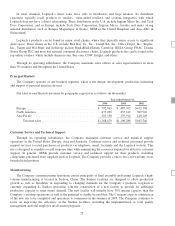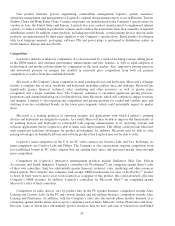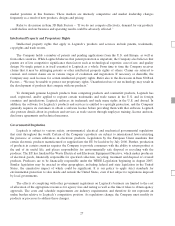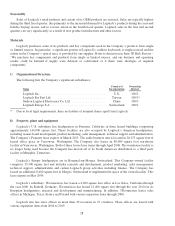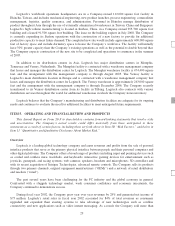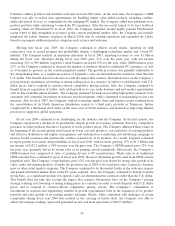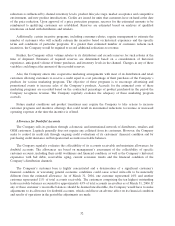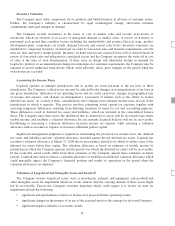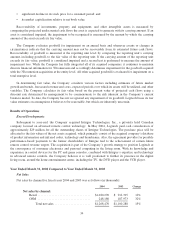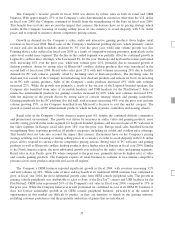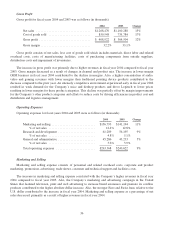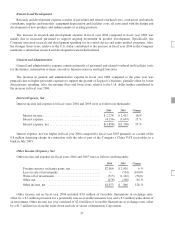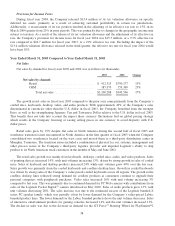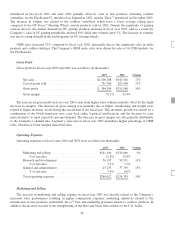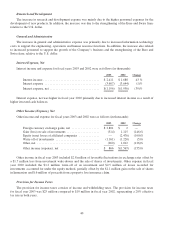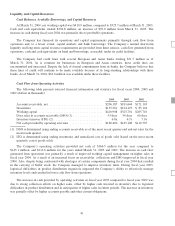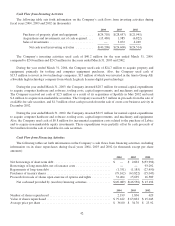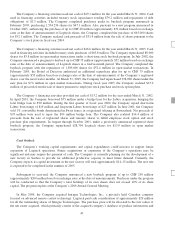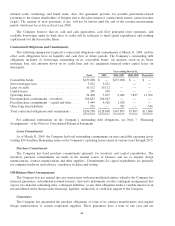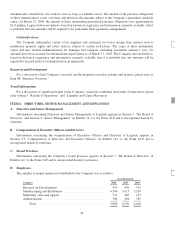Logitech 2004 Annual Report Download - page 73
Download and view the complete annual report
Please find page 73 of the 2004 Logitech annual report below. You can navigate through the pages in the report by either clicking on the pages listed below, or by using the keyword search tool below to find specific information within the annual report.
The Company’s revenue growth in fiscal 2004 was driven by robust sales in both its retail and OEM
business. With approximately 47% of the Company’s sales denominated in currencies other than the U.S. dollar
in fiscal year 2004, the Company continued to benefit from the strengthening of the Euro in fiscal year 2004.
This benefit does not take into account the impact that currency fluctuations have on its pricing strategy which
results in the Company lowering or raising selling prices in one currency to avoid disparity with U.S. dollar
prices and to respond to currency-driven competitive pricing actions.
Growth in demand for the Company’s video, audio and interactive gaming products drove higher retail
revenues in fiscal year 2004. Retail sales of the Company’s traditional pointing devices, which primarily consist
of mice and also include trackballs declined by 3% over the prior year, while unit volume growth was flat.
Pointing device sales suffered in fiscal year 2004 as a result of competitive pricing pressures, particularly in the
entry-level corded mice segment. The decline in the corded segment was partially offset by continued growth in
Logitech’s cordless mice offerings, which increased 8% for the year. Desktops and keyboard revenues performed
well, increasing 10% over the prior year, while unit volume grew 20%, primarily due to sustained growth of
desktop products, driven by strong sales of Bluetooth®cordless desktop products that were introduced in the
second half of fiscal year 2004. Retail video sales grew 25% with unit volumes increasing 29% due to healthy
demand for PC web cameras, partially offset by declining sales of dualcam products. The declining sales for
dualcams was a result of the Company not introducing new dualcam products and reflects its focus on investing
in its PC web camera products. Sales of the Company’s audio products increased 43% while unit volumes
increased 22%. While the growth was primarily a result of the success of the Logitech branded speakers, the
Company also benefited from sales of its mobile headsets and USB headsets for the PlayStation®2. Sales of
interactive entertainment products for gaming consoles increased by 60% while unit volumes increased 83%,
with the majority of the growth driven by strong sales of console steering wheels and gaming controllers.
Gaming peripherals for the PC platform also did well, with revenues increasing 44% over the prior year and unit
volume growing 35%, as the Company benefited from Microsoft’s decision to exit this market category. The
growth occurred across all PC entertainment products, which include joysticks, controllers and steering wheels.
Retail sales in the Company’s North America region grew 6% despite the continued difficult competitive
and promotional environment. The growth was driven by increases in audio, video and gaming products, most
notably strong growth in the audio segment for Logitech branded speakers and increased sales of PC webcams in
the video segment. In Europe, retail sales grew 18% over the prior year. Europe retail sales benefited from the
strengthening Euro, reporting growth in all product categories, including its corded and cordless mice offerings.
This benefit does not take into account the impact that currency fluctuations have on the Company’s pricing
strategy resulting in it lowering or raising selling prices in a currency in order to avoid disparity with U.S. dollar
prices and to respond to currency-driven competitive pricing actions. Strong sales of PC webcams and gaming
products as well as Bluetooth cordless desktop products drove higher sales in Europe in fiscal year 2004. Similar
to the North America region, the most substantial growth was realized in the audio, video and gaming segments.
Retail sales in Asia Pacific grew 8% when compared to the prior year, primarily driven by higher sales of video
and console gaming products. The Company expects its retail business to continue to face intense competitive
pressure across most product categories and across all regions.
The Company’s OEM business reported significant growth in fiscal 2004, with revenues increasing 32%
and unit volumes up 22%. While sales of mice and keyboards to its traditional OEM customer base continued to
grow in fiscal year 2004, the most substantial growth came from OEM console peripheral sales. The growth in
gaming console peripherals was attributable to sales to Sony of the EyeToy™camera and USB headsets for the
PlayStation2. OEM sales represented 20% of the Company’s net sales in fiscal year 2004, compared to 17% in
the prior year. While the Company believes it is well positioned for continued success in its OEM PC business, it
does not foresee sustainable growth in its OEM console peripheral business, particularly as the nature of
opportunities in this market are difficult to predict, as they are sensitive to trends in the gaming industry,
including customer preferences and the popularity and nature of games that are introduced.
35


